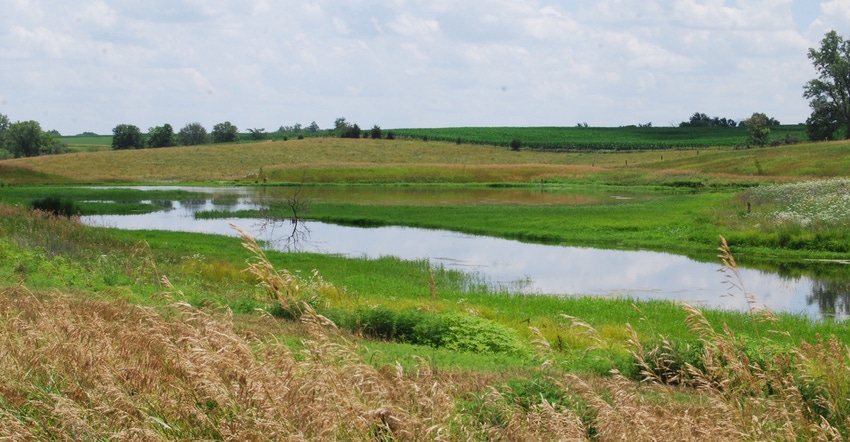September 21, 2018

Just when many thought the 2015 Clean Water Rule of the U.S. was relegated to the archives of history, it has been revived. As of mid-September, WOTUS is the controlling definition for “waters of the United States” in 22 states. As of Sept. 18, Iowa was no longer among them. And the status for the remaining states could change at any time.
The saga — a case study on the intricacies of administrative law — is far from over. In the meantime, landowners planning activities potentially impacted by WOTUS face uncertainty.
WOTUS defines those waters over which the federal government has Clean Water Act jurisdiction. Section 402 of the CWA authorizes the U.S. Environmental Protection Agency to issue permits for discharges of “pollutants” through a “point source,” such as certain confined animal feeding operations.
Section 404 of the CWA authorizes the U.S. Army Corps of Engineers to issue permits for the discharge of dredged or fill material into “navigable waters.” Landowners must get these permits if they want to conduct most any activity on an area determined to be a “wetland.”
People who discharge pollutants or fill material without obtaining a permit face fines up to $37,500 per day per violation, in addition to potential criminal penalties.
Which wetlands, waterways get protection?
WOTUS, which was issued on May 27, 2015, identifies eight categories of “jurisdictional waters,” which include “tributaries” and “adjacent waters.”
Many U.S. states, as well as industry and farming groups, immediately filed lawsuits challenging the implementation of WOTUS. They generally argued that the new rule greatly increased the percentage of waters in the United States subject to CWA jurisdiction, and that the new definition was so expansive that many more landowners would have to obtain permits or pay fines for conducting normal activities, such as spraying weeds, installing a fence or removing trees.
States argued that the rule impinged upon their sovereignty because it sought to regulate intrastate waters over which states have sole jurisdiction.
By the time WOTUS was effective on Aug. 28, 2015, a North Dakota district court judge had already prevented its enforcement in 13 states. In October 2015, the U.S. Court of Appeals for the 6th Circuit stayed WOTUS nationwide, determining in February 2016 that it was the proper court to rule on the merits of all pending claims challenging the rule.
Proposal to rescind or revise rule
By this time, however, Donald Trump as the new president made it clear that he would work to rescind WOTUS. On Feb. 28, 2017, he directed EPA and the Corps to prepare for public notice and comment for a proposal to rescind or revise the embattled rule.
The executive order said that officials should consider incorporating into any new rulemaking the definition of “navigable waters” suggested by Justice Antonin Scalia in Rapanos v. U.S.: “Only those wetlands with a continuous surface connection to adjacent waters covered by the Clean Water Act are ‘waters of the United States.’”
On June 27, 2017, the agencies took the first step of what they called a two-step process to review and revise the definition. Their proposed rule sought to replace the stayed WOTUS rule and recodify “the exact same regulatory text that existed prior to the 2015 rule.” Step two, which has not happened, was to be a review of the appropriate scope of “waters of the United States” and a new definition.
Although the 6th Circuit had issued a stay to prevent enforcement of WOTUS pending the resolution of litigation, the agencies did not want WOTUS to go into effect if that stay was lifted. They had also received 680,000 public comments on the proposed repeal.
Needing time to respond to the comments and develop a new definition, the agencies, in November 2017, proposed a “suspension rule” to delay the applicability date of WOTUS to Feb. 6, 2020.
Plan unravels earlier this year
The agencies said they would work during this time to create a new rule and would continue to operate under pre-2015 law, which required analyzing jurisdictional questions under an ambiguous, yet somewhat less controversial “significant nexus” test.
This plan began to unravel on Jan. 22, when the U.S. Supreme Court ruled that the 6th Circuit had improperly exercised jurisdiction over the WOTUS lawsuits. Instead, the high court ruled the lawsuits should have been heard by the federal district courts. The agencies finalized their suspension rule on Feb. 6, but environmental groups immediately challenged its validity.
When the 6th Circuit lifted its stay on WOTUS on Feb. 28, in response to the Supreme Court decision, only the suspension rule kept WOTUS at bay.
Then on Aug. 16, a South Carolina district court judge struck down the suspension rule, finding that the agencies had failed to comply with administrative law when finalizing the rule. They had not, the court found, properly solicited and considered public comments on the impact of the delay of WOTUS. The court immediately enjoined that suspension rule nationwide.
22 states now subject to WOTUS
This means WOTUS immediately became effective in any state where a district court had not issued an injunction preventing its application. Previous orders from district courts in North Dakota and Georgia stopped WOTUS from being applied in 24 states. On Sept. 12, a Texas federal district court stopped WOTUS from being effective in three more states, pending resolution of legal challenges to the rule.
On Sept.18, a North Dakota federal district court judge added Iowa to the list of states impacted by the stay. The pre-2015 “waters of the United States” legal framework applies in these 28 states. This leaves 22 states, however, still subject to WOTUS. And that number could change any time.
Shortly after the South Carolina decision, EPA and Army Corps of Engineers issued a public statement saying they are continuing to review the court decision, and that they “have filed motions appealing the order and seeking a stay of the district court’s decision. While the litigation continues, the agencies are complying with the district court’s order, and implementation issues that arise are being handled on a case-by-case basis.”
The Trump administration remains committed to repealing and revising WOTUS. As the events of the past months have shown, however, revising a final administrative rule is complicated and time-consuming.
Administrative law requires proper notice, time for comments and a demonstration that all comments have been properly considered. The agencies have appealed the South Carolina court’s order to the 4th Circuit. The status quo could change any time. We will keep you posted as this complex matter continues to play out in court.
Tidgren is an attorney and director of the Center for Ag Law and Taxation at ISU. Contact her at [email protected].
About the Author(s)
You May Also Like






